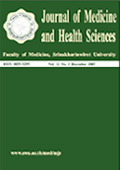Acute effects of barakol and serotonergic drugs on exploratory behaviour in rats
Keywords:
barakol, holeboard, exploration, receptors, serotoninAbstract
Barakol (10 mg/kg, i.p.), an active ingredient extracted from Cassia siamea, has been shown to have anxiolytic properties on the elevated plus-maze at a low dose similar to diazepam and to increase exploratory and locomotor behaviour. Drugs increasing serotonergic function also alter exploratory activity. The mechanism underlying the effects of barakol on exploratory behaviour has not been studied, therefore, the aim of the present study was to investigate exploratory activity in rats treated with barakol compared with drugs known to have specific action on the 5HT system. Exploratory behaviours were monitored in the rat using the holeboard model. The results show that the 5HT1A receptor agonist 8-OH-DPAT (1 mg/kg, i.p.) significantly (P<0.05) decreased exploratory behaviours including rearing, number of head dips and time spent head dipping and the effects were antagonised by the selective 5HT1A receptor antagonist WAY 100635 (1 mg/kg, s.c.). Paroxetine (20 mg/kg, i.p.) also significantly (P<0.05) reduced all exploratory activity and grooming. In contrast, barakol (10 mg/kg, i.p.) and diazepam (1 mg/kg, i.p.) had no effect on exploration. In conclusion, a low dose of barakol has no effect on exploratory behaviours using the holeboard test indicating that 5HT mechanism and 5HT1A receptor may not involved in the anxiolytic effects of barakol.Downloads
How to Cite
1.
Saiyudthong S, Thongsaard W, Marsden CA. Acute effects of barakol and serotonergic drugs on exploratory behaviour in rats. J Med Health Sci [internet]. 2008 Oct. 8 [cited 2026 Jan. 18];12(3). available from: https://he01.tci-thaijo.org/index.php/jmhs/article/view/61333
Issue
Section
Original article (บทความวิจัย)



